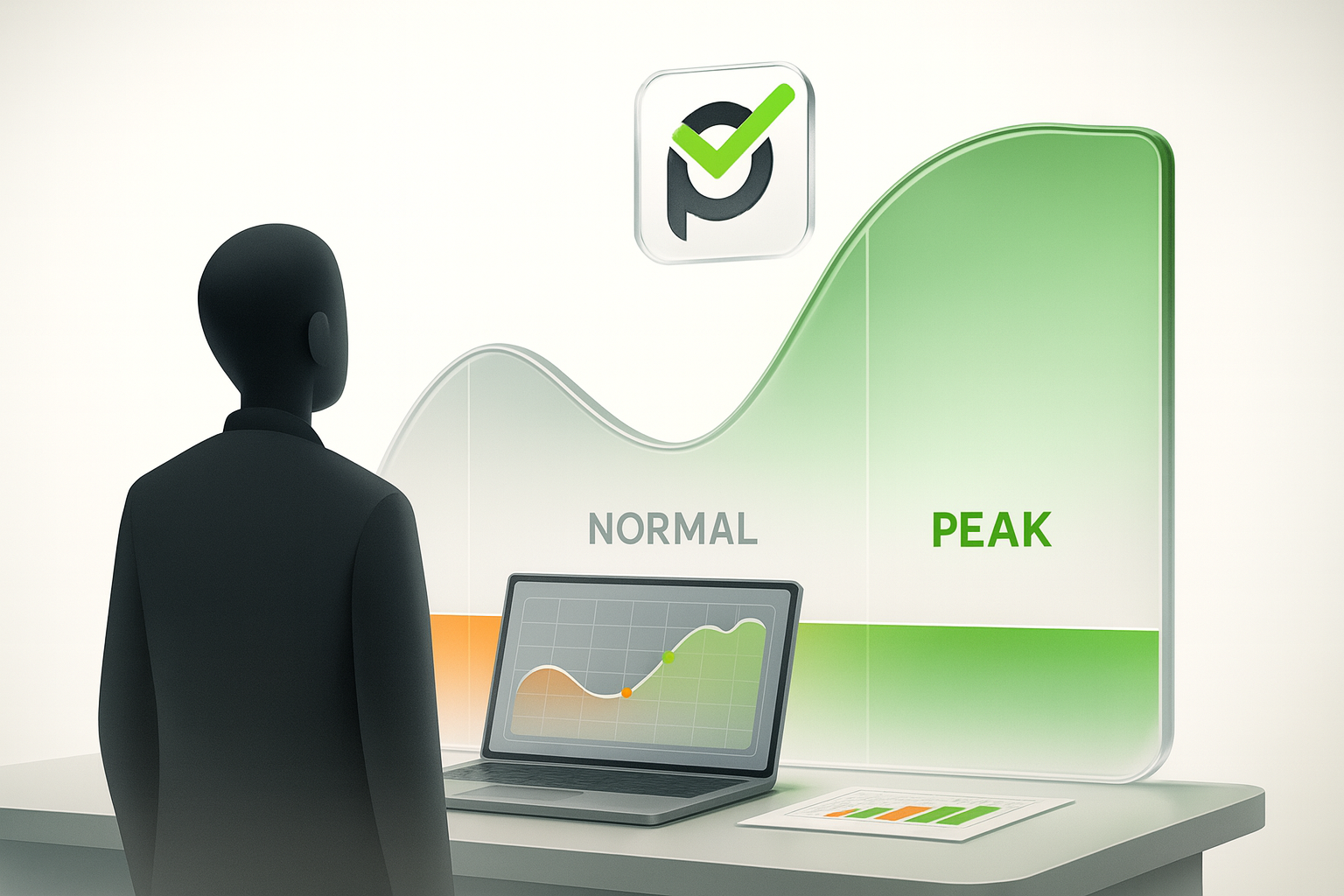
Most managers feel the impact of staffing long before they have a formal name for the problem. A surge in requests suddenly stretches the team, a slow period leaves people underloaded, or a seasonal peak arrives even though everyone knew it was coming. This is where workforce forecasting starts to matter. Instead of guessing how many people you’ll need, you work with a clearer picture of upcoming demand.
The idea itself is simple enough, but many leaders still ask what is workforce forecasting in practice? It involves spotting patterns in workload, identifying when demand tends to rise or fall, and understanding how your team’s availability shifts throughout the year. That’s the essence of the workforce forecasting definition — predicting staffing needs before pressure builds, not after schedules begin to crack. And because field and service industries depend on precision, these predictions quickly become a core part of daily operations.
Digital tools have made the process far more accurate. Modern systems pull together historic job data, peak workloads, shift patterns, and capacity limits. They uncover trends that aren’t visible in spreadsheets and help managers plan proactively rather than reactively. This is why forecasting in workforce management is becoming standard practice: when your staffing aligns with real demand, everything from service quality to employee morale improves.

Workforce forecasting is essentially the process of predicting how many people your business will need — and when you’ll need them. It brings structure to something that usually feels unpredictable: demand spikes, seasonal patterns, staffing shortages, or days when the workload suddenly doubles. When companies rely on guesswork, schedules fall apart quickly. But when they rely on workforce forecasting, staffing becomes steadier, and managers stop scrambling to cover shifts at the last minute.
A lot of everyday problems in operations come down to something simple: the team isn’t staffed the way the workload actually behaves. Too few people during a busy stretch leads to rushed visits and missed deadlines; too many during a quiet week turns into wasted payroll. That’s where forecasting in workforce management becomes useful. It gives managers a clearer sense of when pressure will build, which roles will feel it first, and where extra coverage might be needed. With that kind of visibility, hiring, scheduling, and cross-training decisions feel less like guesswork and more like early course corrections that keep service levels steady.
The workforce forecasting definition is easier to understand once you look at how teams actually work day to day. Most managers already watch past workloads, busy weeks, and the kinds of tasks that tend to drag out longer than expected — they just don’t always connect those dots. Forecasting does exactly that. Instead of relying on instinct, it pulls those patterns together so you can see what’s coming. And when someone asks what is workforce forecasting in plain language, the answer is pretty simple: you look at the history of your workload to get a reasonable sense of what the next stretch is going to demand.
The core idea isn’t complicated, but its impact is big. When you know in advance which weeks will require more staffing, which roles will be stretched the most, and where gaps might appear, you can prepare without stress. Strong forecasting makes the schedule feel less like a puzzle and more like a plan.
##How Does Workforce Forecasting Work in Practice?

In most companies, forecasting starts with a simple question: “What will our workload look like next week, next month, or during the next busy period?” Workforce forecasting brings structure to that question by pulling together real data — job volume, seasonality, technician availability, customer demand, shift patterns, and even past mistakes. When these signals are analyzed together, managers can see upcoming pressure points long before the team starts feeling them. That’s the foundation of workforce management forecasting: spotting the future early enough to plan around it.
Workforce demand forecasting answers the question: “How much work is coming our way?” It looks at patterns in job volume, recurring service peaks, seasonal fluctuations, holidays, marketing campaigns, and anything else that influences how busy the team becomes. In service industries, even small changes — a heatwave, a product launch, a regional event — can shift workload dramatically.
Demand is only half of the equation. The other half is understanding who will actually be available to do the work. Forecasting workforce supply means looking at technician schedules, PTO, turnover risks, skill gaps, training plans, shift patterns, and even fatigue levels during high-pressure periods. A team may be large on paper, but availability can drop quickly once vacations, sick days, and specialized skills are factored in.
This part of workforce management forecasting helps managers avoid situations where demand is high but critical roles are understaffed. When supply forecasting is accurate, scheduling becomes far more controlled and less reactive.
Balancing both sides — demand and supply — is where workforce forecasting and scheduling come together. The goal isn’t to build a perfect schedule; the goal is to build one that reflects reality. Some weeks will require more hands on deck, some roles will need backfilling, and some shifts will need to be reshaped to match customer expectations.
When companies apply workforce management forecasting and scheduling correctly, the schedule stops feeling like a weekly puzzle. Managers can staff critical days ahead of time, reduce overtime, and prevent the domino effect that happens when one overloaded shift disrupts the entire week. The result is a more predictable operation — and a team that isn’t constantly stretched thin.

Workforce forecasting isn’t one single method — it’s a mix of approaches that help you understand what the workload will look like in the near and not-so-near future. Some companies rely heavily on numbers and historical data, while others prefer expert judgment when the environment changes too quickly for past trends to be useful. Most teams eventually blend both, because no single model works perfectly on its own in every situation. That’s why understanding different workforce forecasting models helps you pick the method that actually fits your operation instead of forcing your planning into the wrong shape.
Quantitative methods are usually the first place people look when they start exploring workforce forecasting models, mostly because the numbers are already there — job counts, busy seasons, repeat patterns, the odd spikes that happen every year for reasons no one fully remembers. Trend analysis helps you notice whether demand has been creeping up or leveling off. Regression digs a little deeper and shows how certain factors — temperature, marketing pushes, outages — influence workload. And time-series models focus on the rhythms that repeat themselves: the months that always heat up, the weeks that always dip. None of these techniques promise perfect predictions, but together they give you a grounded view of what the next stretch of work is likely to look like.
Quantitative models don’t always capture everything, especially when the business is changing quickly. That’s where qualitative forecasting comes in. These models rely on expert judgment, industry knowledge, and scenario planning instead of purely historical numbers. For example, if your company is about to introduce a new product line or expand into a new region, there may be no past data to rely on. In those moments, conversations with field supervisors, HR leaders, and operations managers become far more valuable.
Scenario planning is another major piece. It helps teams imagine several “possible futures” — a surge in demand, a slow season, a staffing shortage — and prepare responses for each one. This approach fits perfectly with forecasting in workforce management, where conditions often shift faster than the data can catch up.
There’s no universal answer to which model is best. A stable business with long-term data might lean on quantitative forecasts, while a fast-growing team or a company entering new markets may rely more on expert judgment. In reality, most organizations mix the two — using hard data as a baseline and adjusting it with situational insight. The key is choosing an approach that reflects your reality, not someone else’s.
If you’re still deciding where to start, begin simple. Use historical patterns when they’re reliable, and add qualitative insight when numbers don’t tell the whole story. As your operation matures, you can refine your workforce forecasting approach into something far more precise.
When workforce forecasting and scheduling work together, the entire operation becomes more predictable. You stop running short-staffed on your busiest days, overtime becomes an exception instead of a weekly habit, and customers feel the difference almost immediately. The goal isn’t perfection — it’s eliminating the avoidable chaos that comes from not knowing what the next week or month will look like. Good forecasting brings stability, and stability is what most service teams struggle with the most.
Labor is one of the largest expenses in any service-based organization, and small inefficiencies add up quickly. Accurate workforce forecasting helps teams match staffing levels to real demand so they’re not overspending during quiet periods or scrambling to pay overtime during busy ones. When you can see peaks and dips coming, resource planning becomes far more intentional — less guesswork, fewer last-minute fixes, and more control over the budget.
Accurate planning also limits the hidden costs. Things like burnout, turnover, and idle time aren’t always captured in spreadsheets, but they’re expensive. A well-built forecast reduces those risks by aligning workload with actual capacity.
Poor scheduling forces technicians into long days, unpredictable shifts, and constant rescheduling. With proper workforce management forecasting and scheduling, you can build a schedule that spreads work more evenly and respects everyone’s limits. Instead of reacting to yesterday’s problems, managers can shape next week’s staffing with a clear sense of what’s ahead.
Overtime becomes easier to manage too. When you know in advance which days will stretch the team, you can add support early rather than pushing the same technicians past their limits. That small shift — from reactive to proactive — makes the entire schedule feel calmer.
Customers feel the impact of staffing more than most teams realize. Delayed appointments, slow response times, and rushed visits often trace back to understaffing, not skill. Strong forecasting in workforce management keeps workloads balanced so technicians aren’t racing from job to job. When the schedule is realistic, the quality of service improves naturally.
Employees feel it too. A predictable workload leads to fewer stressful days, clearer expectations, and a healthier pace. In the long run, that stability becomes one of the best ways to improve retention — people stay longer when they’re not constantly running on empty.

Workforce forecasting software takes the scattered pieces of scheduling — past workloads, shift patterns, technician availability, seasonal spikes — and pulls them into one place, so managers don’t have to guess what the next few weeks will look like. Instead of juggling spreadsheets or relying on memory, teams get a clearer view of upcoming staffing needs and can adjust before problems appear. It’s a faster, calmer approach to planning that fits the pace of modern operations.
Most teams care less about fancy dashboards and more about whether the software actually helps them plan the week without guesswork. The core features of workforce forecasting tools usually reflect that reality. They pull in past workload patterns, highlight days that will run hot, and show where staffing might dip before anyone feels the pressure. The best systems don’t try to predict every detail — they simply give managers enough clarity to adjust schedules early, instead of scrambling when the week is already in motion.
The real power of these tools shows up when forecasting connects directly to scheduling. With workforce management forecasting and scheduling, staffing plans flow straight into shift assignments, so coverage gaps, overtime risks, and resource bottlenecks become visible early. It’s a smoother workflow because the forecast doesn’t sit in a separate file — it actively shapes the schedule.
Sometimes the numbers tell a different story than what people remember, and that’s where analytics starts to help. Instead of relying on “I think last month was busy,” the system digs through the actual workload — the long jobs, the odd spikes, the days that always seem to run short for reasons no one can quite explain. Little by little, these patterns make forecasting workforce needs a lot less mysterious. You end up planning from facts instead of gut feelings, which usually leads to fewer surprises down the line.
If you ask most managers what they use to plan staffing, you’ll hear a mix of spreadsheets, notes, last year’s memory, and whatever the CRM can spit out. It works — until it doesn’t. Forecasting tools step in at the moment when the old methods simply can’t keep up with shifting demand, seasonal spikes, or uneven workloads. The best tools aren’t the fanciest ones; they’re the ones that help you see what’s coming without forcing you to become a data scientist. They gather scattered bits of information, show patterns you’d otherwise miss, and give you enough lead time to adjust your staffing before a busy week turns into a stressful one.
A good forecasting tool doesn’t try to predict the future perfectly — it tries to give you a clearer sense of what next month is likely to look like based on what the last few years have taught you. The most helpful systems pull together job counts, customer patterns, seasonal shifts, and the odd spikes that always seem to happen at the worst possible time. They lay it out in charts or dashboards that make sense at a glance. When these features work together, workforce forecasting models become much easier to use, because you’re not digging through data; you’re interpreting what the tool is already showing you in plain language.
Automation takes the grunt work out of forecasting. Instead of you trying to remember whether last April was unusually busy, the system just checks. It updates trends every day, not once a quarter. It notices when job duration starts creeping up, or when certain tasks consistently run long, and folds that into the prediction without asking anyone to sit and crunch numbers. This is where workforce management forecasting and digital tools feel genuinely helpful: the software keeps learning, even on the days when no one has time to look closely at the reports.
The other advantage is speed. When the market shifts, or when something unexpected happens — a promotion, a heatwave, a regional outage — manual forecasting falls behind almost immediately. Automated systems catch the shift as soon as the numbers spike. It’s not about replacing intuition; it’s about giving your intuition better information to work with.

Most field teams don’t struggle because they lack effort — the real problem is that the workload doesn’t always match who’s actually available to handle it. Planado helps smooth that mismatch in a way that feels grounded rather than theoretical. The system keeps a detailed record of past jobs, durations, skill requirements, and how the team’s workload usually shifts during busy stretches. Managers can look at these patterns directly in the reports instead of trying to piece them together from memory. It’s not about generating a perfect forecast; it’s about giving you enough context to make the next week’s schedule more realistic.
What teams usually appreciate most is how naturally this information fits into the workday. You don’t have to open a separate module or dig through hidden menus — the same scheduling board technicians rely on already reflects job history, assignments, and real availability. When demand starts building in a certain area, it becomes obvious. When availability thins out, that’s visible too. Planado surfaces these pressure points early, which makes it easier to balance the week, prevent last-minute overtime, and avoid those stressful end-of-day surprises that drain morale. In busy operations, that kind of clarity often becomes the difference between constantly catching up and running a schedule that actually feels under control.
If you’re not sure whether your current planning method is keeping up with real demand, take a fresh look at your workload patterns. Check where the team gets overloaded, where overtime keeps popping up, or where schedules fall apart during seasonal peaks — these are signs that a forecasting tool like Planado could steady the entire operation far faster than manual planning ever will.
Workforce forecasting isn’t some abstract HR exercise — it’s one of those quiet practices that makes the whole operation run smoother once you start using it properly. When you can see busy stretches coming, or notice the weeks where coverage will dip unless you intervene, scheduling stops feeling like a crisis-management routine. The whole point of good forecasting in workforce management is to replace surprises with expectations, so the team isn’t scrambling every time demand shifts a little faster than memory can keep up.
The companies that get the most value out of forecasting aren’t the ones with the biggest datasets — they’re the ones that use the information to shape the week with intention. Better balance, fewer overtime headaches, steadier service quality. And if you want a simple way to put that into practice without drowning in spreadsheets, Planado brings forecasting and scheduling into one place. If you’re ready to make your planning less reactive and more predictable, explore how Planado helps field teams match staffing with real demand and build schedules that actually hold up on busy days.
How is workforce demand forecasting used in service industries? Workforce demand forecasting helps service teams spot when call volume, job requests, or customer visits are likely to rise. It gives managers enough time to prepare staffing before the pressure hits. This approach keeps schedules steady and helps avoid last-minute overtime.
What factors influence forecasting in workforce management? Forecasts depend on workload patterns, seasonality, technician availability, job duration, and even unexpected events like regional outages. These signals help shape more realistic staffing plans. When teams track the right inputs, forecasting in workforce management becomes far more reliable.
How do workforce forecasting tools help managers plan for seasonal changes? These tools analyze past busy seasons, identify recurring spikes, and highlight the weeks that typically stretch the team. Managers can then adjust schedules, bring in support, or shift resources before the rush arrives. Strong workforce management forecasting turns seasonal swings into something predictable rather than stressful.
How can automation and AI improve workforce management forecasting? Automation handles the repetitive work — updating data, recalculating trends, and flagging sudden workload changes. AI picks up patterns that humans usually overlook, especially in large operations. Together, they make workforce management forecasting and scheduling faster, clearer, and far more precise.
